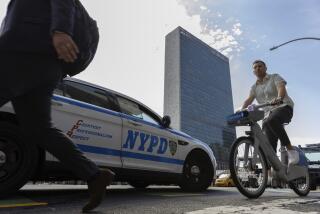United versus United Nations
- Share via
GREENWICH, Conn. — A weary world was waiting, but this wealthy town begged to differ.
It was the mid-1940s, and more than 60 cities across the country were competing to land the headquarters of the United Nations. The new organization settled on the Gold Coast community, drawn by its proximity to New York City and abundant and attractive land.
The project was supposed to be a centerpiece of a new era of peace following World War II. But it would entail taking by eminent domain the estates of influential figures in media, sports, entertainment, politics and finance, including musician Benny Goodman and Time magazine founder Henry Luce.
A town leader named Prescott Bush -- on his way to founding a political dynasty -- would play a key role in the debate, which would at times turn ugly, even farcical.
In the end, residents overwhelmingly rejected a plan to base the United Nations in Greenwich. A new exhibit at a Greenwich museum explores how and why the town opposed a project that symbolized a new era of idealism.
The exhibit includes oral accounts recorded in the 1970s by participants, letters written by supporters and opponents, a petition, photos and sketches of buildings.
With so much competition to attract the headquarters, U.N. officials assumed they would be welcomed in Greenwich, a wealthy suburb of New York that gained notoriety in more recent years for complaints about hordes of out-of-state Powerball players and a failed effort to keep nonresidents off its beaches.
“They were kind of taken aback and shocked that Greenwich wasn’t opening its arms to them,” says Grady Turner, curator of the Historical Society of the Town of Greenwich, which is sponsoring the exhibit.
While supporters saw the project as vital for world peace, opponents feared the impact on the town. A few smelled a communist plot; some made anti-Semitic remarks. One opponent hatched a scheme to scare local shopkeepers: He dispatched two Syrians and an Irishman who dashed around the ritzy downtown chalking off measurements and speaking gibberish.
“There was incredible goings-on,” says Bernie Yudain, the Greenwich Time reporter who broke the story of the plan. “That whole period was kind of fascinating.”
Yudain, now 85, says he received a tip from Bush that the United Nations had proposed putting its headquarters in Greenwich’s backcountry. Within a day the story was making headlines around the world.
The United Nations planned to create a mini-city with numerous buildings on 42 square miles -- and then expand the complex to more than 100 square miles into neighboring New York and Stamford.
The sketches envisioned a “vertical garden city” of steel and glass skyscrapers that would house not only the United Nations but a world library, museum, law faculty and exhibit of “world urbanism.”
The plan, dubbed “UNOville” by newspapers, would absorb the homes of Goodman; Luce and his wife, U.S. Rep. Clare Boothe Luce; financier Frank Altschul; department store magnate Bernard Gimbel; and boxer Gene Tunney.
“If the U.N. tried harder, they couldn’t have found an area that was a better cross-section of the upper echelons of American society,” Turner says.
Opponents moved quickly, raising $29,000 and gathering more than 900 signatures on a petition. Residents said they felt no hostility toward the United Nations or the hopes for world peace, but worried the project would “change the character of the community, which up to this time has been purely residential.”
A newspaper in London called the residents snooty, saying they didn’t want foreigners in their midst. A letter writer said she would find it hard to face people in war-torn Europe.
“I am afraid there are many of us who have lost loved ones in this war who find it hard to understand the attitude of the greater number of you at Greenwich,” Dorothy Bear wrote.
Bush, who later became a U.S. senator and the father and grandfather of presidents, was among the elected officials who worked to keep the United Nations out of Greenwich. His property would not have been affected by the proposal but he feared an international city would destroy the town’s character, according to the exhibit.
Some opponents equated the United Nations with communism or made racist allusions.
“Some of the way it was articulated was they didn’t want to see camels on Greenwich Avenue,” Turner says.
Amedee Cole, who organized public relations for the opposition, acknowledges years later that he hired the Syrians -- one of whom wore a fez -- and the Irishman. They pretended to speak another language and refused to answer questions from business owners, Cole says.
“That was $50 well spent,” he says. “I think it bought us probably several hundred votes on the referendum.”
Henry Luce suggested the referendum. In a nonbinding vote, 73% of voters opposed the U.N. headquarters.
U.N. officials, frustrated that a year of work had yielded nothing, turned to New York, where movers and shakers such as Robert Moses and the Rockefeller family quickly came up with the cash and property for what is now the United Nations. This time, the project would displace a much poorer area dominated by tenements, slaughterhouses and small businesses.
The exhibit is a reminder that Greenwich, and the United Nations, could have turned out dramatically different, Turner says.
“It speaks to a moment when the residents of Greenwich stood up to recognize the identity of their place,” he says. “They wanted to preserve that identity.”
More to Read
Sign up for Essential California
The most important California stories and recommendations in your inbox every morning.
You may occasionally receive promotional content from the Los Angeles Times.










